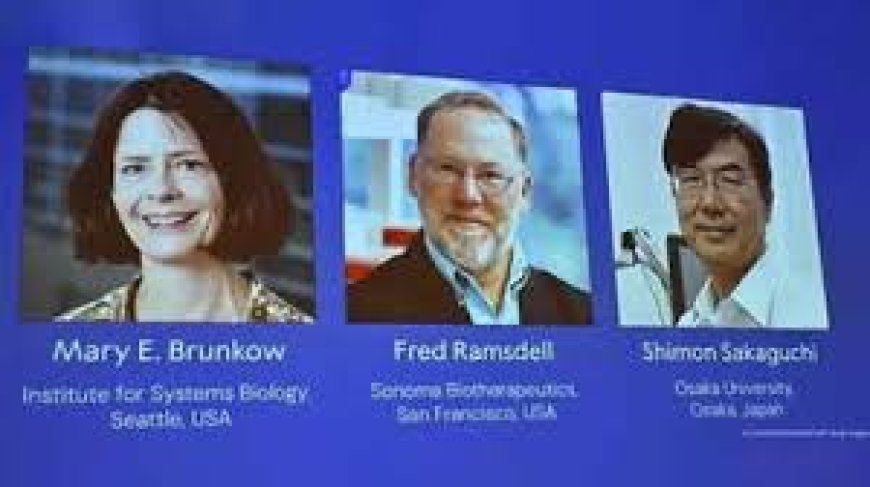The Nobel Prize Winners of 2025: Taza News Explains the Immune System Breakthrough
2025 Nobel Medicine Prize: Brunkow, Ramsdell, Sakaguchi won for discovering how "Regulatory T cells" stop the immune system from attacking the body. A huge step for treating autoimmune diseases and cancer.
Every year, the Nobel Prize in Medicine highlights a scientific breakthrough that changes our world. This year’s award is one of those moments. The 2025 prize was given to three brilliant scientists—Mary E. Brunkow, Fred Ramsdell, and Shimon Sakaguchi—for figuring out one of the biggest mysteries of our body: How does our immune system know when to stop fighting?
It sounds simple, but this discovery is a huge deal for millions of people who suffer from conditions like Lupus, Type 1 Diabetes, and Rheumatoid Arthritis.

At Taza News, we want to break down this complex science into simple terms so you can understand why this work is so important.
The Problem: Your Immune System's Friendly Fire
Think of your immune system as an elite security force protecting a city. Its job is to spot intruders (viruses, bacteria, etc.) and destroy them. This is what it does thousands of times a day.
But what happens when this security force gets confused and starts attacking the city’s own buildings and residents? That’s what we call an autoimmune disease. It's the body turning on itself.
For decades, scientists knew how the body trained its immune cells (called T cells) in a special organ called the thymus. They thought any cell that might attack the body was eliminated there. This was the "central control." But this explanation was incomplete. A small number of "rogue" cells still escaped the training camp, and yet, most people don't develop severe autoimmune diseases. Something else had to be keeping them in check.
The Breakthrough: The Immune System's Peacekeepers
The three Nobel laureates solved this puzzle by finding the immune system’s secret set of "peacekeepers" and the master switch that controls them.
Chapter 1: The Discovery of the Security Guards (Shimon Sakaguchi)
Back in the 1990s, Dr. Shimon Sakaguchi of Japan decided to look for a different mechanism of control, one that worked outside the thymus (what scientists call "peripheral tolerance").
He discovered a brand-new type of immune cell that didn't attack invaders—it suppressed the immune system's own aggressive cells. He called them Regulatory T cells (or Tregs). These are the security guards that step in and tell the other, overzealous T cells to "calm down" and stop attacking the body’s healthy tissues. This was the first piece of the puzzle.
Chapter 2: Finding the Master Switch (Mary Brunkow and Fred Ramsdell)
A few years later, in the US, Mary Brunkow and Fred Ramsdell were studying a strain of mice that suffered from severe autoimmune diseases. After painstaking genetic research, they found a single flaw in a specific gene, which they named Foxp3. This gene defect completely disabled the mice’s ability to regulate their immune system, leading to the body’s defenses running wild.
Crucially, they realized the human version of this gene was responsible for a rare but fatal autoimmune condition in children, proving this gene was a master control for preventing self-attack.
Chapter 3: Linking the Two
Finally, Dr. Sakaguchi connected the dots. He proved that the Foxp3 gene—the master switch found by Brunkow and Ramsdell—was exactly what controlled the development and function of the Regulatory T cells—the peacekeepers he had discovered.
The whole system suddenly made sense: The Foxp3 gene tells the body to create the Tregs, and the Tregs patrol the body, ensuring the main immune army doesn't commit friendly fire.
Why This Matters for You
This isn't just a win for science; it’s a massive step forward for human health.
-
Hope for Autoimmune Diseases: In conditions like Multiple Sclerosis or Type 1 Diabetes, the patient’s Tregs are often either too weak or too few. Now that scientists understand the mechanism, they can work on therapies to boost the number of Tregs or make them more powerful. This could one day lead to cures, or at least far better treatments, than the current drugs that just broadly suppress the entire immune system.
-
Better Cancer Treatments: In some cancers, the tumors actually recruit Tregs to protect themselves from the body's own immune attack. Researchers are now looking at ways to temporarily disable or remove those Tregs near a tumor, allowing the immune system to finally fight the cancer effectively.
-
Safer Organ Transplants: When someone receives an organ transplant, the body’s immune system naturally views the new organ as an enemy and attacks it (rejection). By using Tregs, doctors hope to train the immune system to tolerate the new organ without having to rely on harsh immunosuppressive drugs that leave the patient vulnerable to infection.
The work of Brunkow, Ramsdell, and Sakaguchi has launched an entire new field of medicine. It gives millions of people battling chronic illnesses a strong reason for hope. It's a reminder that fundamental research, even on something as tiny as a T cell, can have the largest impact on human life.






















